Comic for December 30, 2019
https://ift.tt/37reb8B
fun
via Dilbert Daily Strip http://dilbert.com
December 30, 2019 at 02:19AM
Just another WordPress site
Comic for December 30, 2019
https://ift.tt/37reb8B
fun
via Dilbert Daily Strip http://dilbert.com
December 30, 2019 at 02:19AM
Darktable 3.0 released with new features, bug fixes and major GUI update
https://ift.tt/2Q2Vmmf
 |
Darktable 3.0, the latest version of the open source photo editing software DPR reported on early last month, has officially been released. As revealed when the first release candidate was made available for public testing, Darktable 3.0 brings a number of large changes and improvements to the software, including a reworked GUI that makes it possible to apply full themes to the software.
‘Darktable’ will be the default theme in Darktable 3.0, but users will also be able to use alternatives like the ‘Darktable Elegant Dark,’ a lighter version of the theme, and ‘Darktable Elegant Darker,’ which has more condensed fonts best used with the Roboto font, according to the developers.
 |
GUI changes aside, Darktable 3.0 adds a number of improvements and new features, including ‘many changes’ to the ‘denoise (profiled)’ module, a rewrite of the previous Picasa export module that switches it over to Google Photos, the addition of new ‘RGB Curve’ and ‘RGB Levels’ modules, a new ‘Basic Adjustments’ module, new color pickers for modules like ‘Watermark’ and ‘Split Toning,’ what the developers refer to as ‘many code optimizations’ for SSE and CPU paths and much more.
In addition to the new features and improvements, Darktable 3.0 includes several bug fixes and support for additional camera models, noise profiles and white balance presets. As expected, the latest version of the software is free to download on Windows, macOS and Linux.
photography
via News: Digital Photography Review (dpreview.com) https://ift.tt/2burdFr
December 27, 2019 at 01:10PM
Actually, 2019’s Gadget of the Year Is My Electronic Chicken Door
https://ift.tt/2Q4Y2jj

The best gadget of the year is neither phone nor laptop nor smartwatch nor headphones. It’s not even something most people need. It is, instead, an automatic chicken door, a simple piece of tech that not only changed my family’s life for the better, it may have also saved my marriage.
When all’s said and done, my legacy as a professional, among my colleagues at least, will have nothing to do with my work and everything to do with the fact that I’m the guy who lives in the woods and has a lot of pets. Fair enough. My house in New York’s Hudson Valley (“It’s about two hours up the Hudson River from Manhattan,” is how I usually explain it to baffled Brooklynites) is currently home to two dogs, four cats, 14 chickens, and a snake.
The dogs are, of course, the neediest of the bunch—our entire life is structured around their various demands, which are many. But they often travel with us, and their demands come with them. The cats are chill and can be left home alone for a few days as long as there’s a pile of food and a couple of full water bowls. Dot, my 15-year-old ball python, can go a full week without needing a thing. It’s the chickens whose fragile feathered lives became a life-altering responsibility.
As livestock go, chickens are relatively low-maintenance. Fill their food and water buckets once a week, let them out to roam, and they’re good. Sure, you have to collect the eggs during the months when they’re laying, but if you miss a day or two, it’s no biggie. The twist is that, when left in an open coop overnight, they will likely all be murdered.
Foxes, raccoons, weasels, neighbors’ dogs—everything wants to eat a chicken. So unless you enjoy coming home to a massacre, you have to make sure the chicks are all locked up tight in their coop each night. This means that, if you have a regular manual chicken door, someone has to be home every day to close it up in the evening and re-open it each morning.
That someone was usually my wife, Jennifer. And that someone was very pissed at me.
Because my office is in New York City, I was invariably home late. This meant that Jennifer, who also has a long commute, had to go home to “close up the chicks,” as we say, rather than go to the gym or yoga or go spend the night visiting her family or friends. This was fine for a while. But after several months, Jennifer had had enough.
“I can’t do this anymore,” she’d say. “I need to be able to be away from the house sometimes. We need to get the electronic chicken door.”
“Okay, yes, you’re right,” I’d say. “I’ll get it, I’ll get it.”
That conversation happened repeatedly for about six months before I finally got it. I took that long because a) I am an idiot, and b) the chicken door I wanted to buy cost hundreds of dollars. I’d purposely spent less than $300 on the entire chicken coop and the chickens themselves, and I didn’t want to double that expense on a single part. Eventually, I gave in and bought the damn thing. Turns out, pretending your partner doesn’t need something because you don’t feel like spending money on it just makes you an asshole.
After swallowing my inner Scrooge and a few evenings exploring chicken forums, I ultimately purchased the exhaustively named ChickenGuard Premium Automatic Chicken Coop Pop Door Opener & Door Kit Combo for $225.
Chickens are primarily controlled by the sun. They mostly stop laying eggs during months when there are fewer than 12 hours of sunlight. The whole crowing-at-dawn thing is true—they wake up with the sun, and the rooster likes to be a dick about it. And like magic, these little meat robots naturally put themselves to bed when the sun starts to go down.
Given that’s how chickens work, the ChickenGuard opener packs a light sensor that automatically opens the metal coop door when the sun comes up and closes at your desired time after sunset. (If you set it to close too early, any lingering chickens get stuck outside, defeating the whole purpose of an automatic door.) It has a simple digital display, a terrible three-button-controlled user interface, and a light that tells you when its batteries are almost dead. And… that’s it, that’s the gadget.
It’s all very quaint, and it just works. It’s also quite obvious to me now, having lived with the automatic chicken door for nearly a year, just how dumb I was for not buying this contraption from the very beginning.
Besides the benefits to our lives, it’s also been good for the chickens. They get to go out into the run even if we sleep in. They don’t get eaten by weasels. And, because we don’t go out to the coop as much during the low-egg months, we failed to notice one of the hens sitting on some eggs for a few weeks, which resulted in a couple of surprise baby chicks.
Eleven months after buying the electronic chicken door, Jennifer is happily untethered from our house, able to stay out late, or travel, or just not worry about the chickens too much. Our flock grew by two. Our neighbors no longer have to drive to our house twice a day to open or close the coop door anytime we go out of town. And I am a better, still-married person, having realized the errors of being a cheap jerk. I got the new iPhone this year. It hasn’t offered anything close to those kinds of benefits.
geeky,Tech
via Gizmodo https://gizmodo.com
December 27, 2019 at 09:36AM
Theoretically, Yoda Wasn’t Even 30 When He Died
https://ift.tt/2QmWGPz

There’s a big, if unintentional, consequence of Baby Yoda’s existence. Because we were told how old the little guy is (50) and we think we have a decent understanding of how old Baby Yoda is developmentally (approximately 18 months) considering what we’ve seen of his actions so far in The Mandalorian, we can infer how old Master Yoda was when he pulled his disappearing act on Luke in Return of the Jedi. If our theory is correct, Jedi Master was so young he probably didn’t even have a 401k.
According to my math, Yoda was only, developmentally speaking, 27 years old when he died.
When Yoda passes in Return of the Jedi we know he’s around 900 years old. He’s aged visibly from Revenge of the Sith set over 18 years before that. Because we see that he ages over the course of nearly 20 years, we can make one major assumption about his species (which is not named in Star Wars canon and will be referred to simply as Yoda for the purposes of this blog)—they continue to age over time and do so in clear visible ways. This means it has senescence—a term referring to creatures (including humans) that mature and age after reaching maturity. This also means Yodas likely do not possess negligible senescence—a trait shared by many turtles and lobsters. Those species age so slowly it is difficult to perceive biologically speaking.
So we know Yodas age. Given Frank Oz’s acting choices when portraying Yoda in Return of the Jedi we might infer that Yoda, while being 900 in Star Wars years, is comparable to a 70-year-old human. But that’s based on our perception of signs of advanced aging, right? Only there are plenty of humans who appear much older than they actually are.
If humans can appear older than they are, then Yodas should theoretically be capable of the same. Unfortunately for our working theory here, we only have three Yodas in our sample size. First, there is Yoda, who we have established ages over the course of 18 years at least. Then there is Yaddle, a female Yoda. Her character model, which appears in The Phantom Menace, was originally designed to be a younger Yoda. Then someone slapped a wig on the puppet and young Yoda became Yaddle.
Yaddle has no association with age apart from the Apocrypha regarding her origin. We cannot know if she is a younger version of the species or older. We can only know she looks like she took too big a hit off the bong and needs some Jack in the Box tacos stat. Baby Yoda expands our sample size of the Yoda species and allows us to better understand how old Yoda was.
Little cherubic nom-able Baby Yoda is 50 years old in The Mandalorian. No approximations needed—Werner Herzog, as the Client, says it in the first episode. Developmentally it’s a little more difficult to guess Baby Yoda’s age exactly compared to a human child. Baby Yoda can drink tea calmly out of an open container and walk and eat frogs which might suggest an age of 3 to 4. However, Baby Yoda cannot yet vocalize beyond gurgles and baby squeals and interacts with non-tea and frog objects like a much younger child. This leads me to believe that developmentally the Child is somewhere between 18 months and 24 months in human parlance.
Now, if the Child is 24 months old that means 2.08 years for a Yoda is approximately the same as one month for a human. If the child is 18 months old that’s 2.78 years per human month. That means that Yoda, at 900 years, was between 27 and 36 developmentally, when he died.
I’m sure his mother is very disappointed that he flamed out so young in his life and fucked off to a swamp before becoming a Force ghost that haunted Luke Skywalker to the end of his days.
For more, make sure you’re following us on our Instagram @io9dotcom.
geeky,Tech
via Gizmodo https://gizmodo.com
December 26, 2019 at 03:30PM
Arming The Space Force: Choosing The Official Space Gun, PART 1
https://ift.tt/2t3LRKc
Ever since President Trump announced that a Space Force should be established, firearms enthusiasts have envisioned space suited door gunners, shooting any variety of futuristic-looking “space guns”. The hope for a phased plasma rifle in the 40-watt range has been renewed once more. As we move closer to the proposed, four year buildup of the United States Space Force, let’s look at some more realistic options for choosing a standard issue firearm of the Space Force. First, though, let’s look at some of the challenges that stand in the way of bringing a firearm into the final frontier.
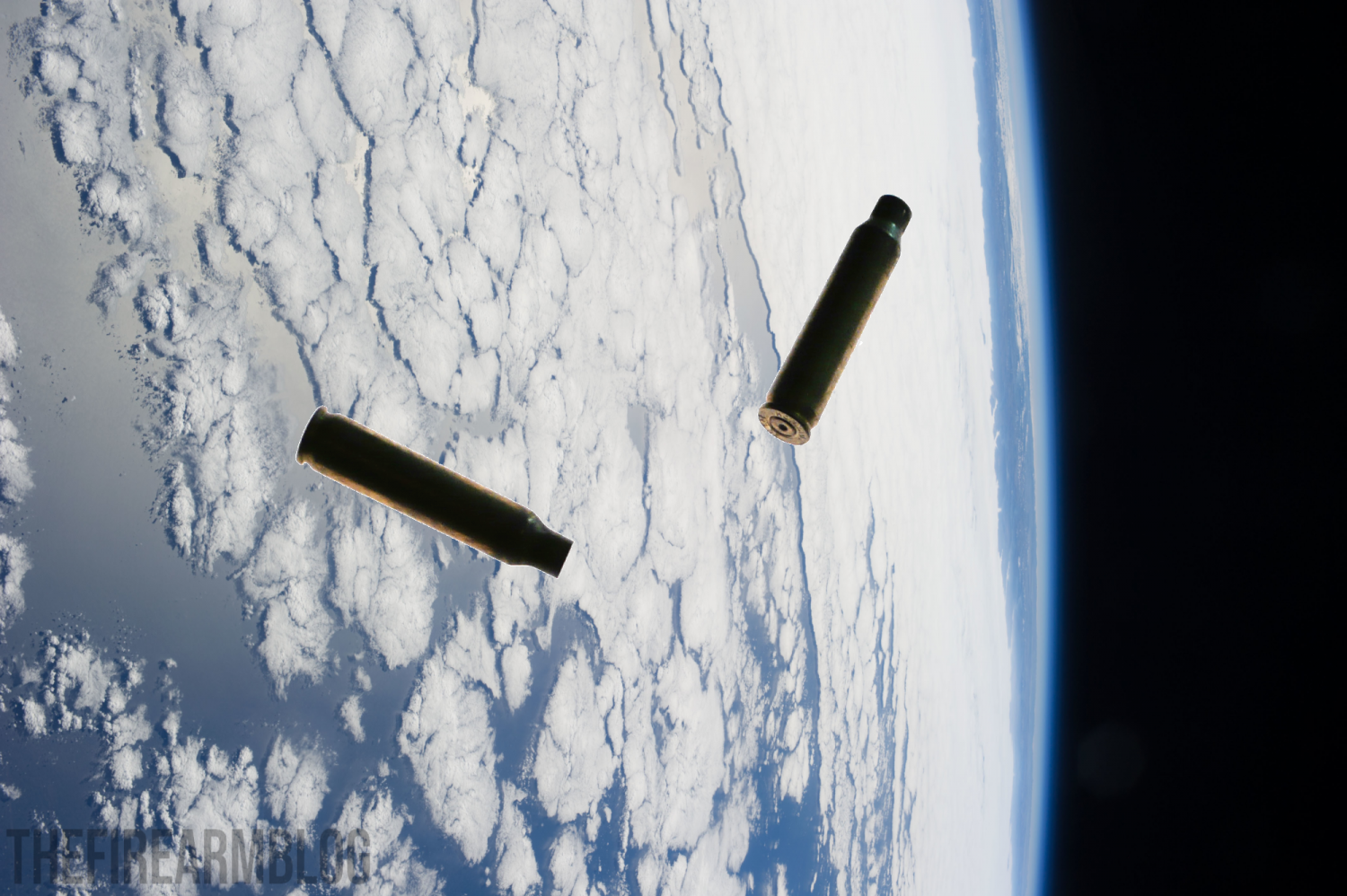
The problem of weight, as it pertains to choosing which firearm to fire in space, comes in two different aspects. Weight of the chosen firearm itself isn’t actually that large of a challenge, but the weight of the bullet it fires can come into play if a spacewalker fires enough rounds. Getting the gun and ammo into space is fairly trivial since each gun will only weigh one and a half to three pounds, which is only a tiny fraction of the weight of the person that will be carrying it.
Firing a gun in space will have an effect on the shooter’s speed and motion, which is based on the weight of the projectile and the position of the gun relative to the center of the shooter’s mass. Sir Isaac Newton’s third law states that for every action, there is an equal and opposite reaction. The heavier the bullet, the more it affects the shooter’s speed, which compounds the issue each time a round is fired. Most basic YouTube explanations of this issue claim that each shot will send an astronaut backwards, which is sort of true, but more accurately, it would really be slowing them down in the context of being in orbit. Either way, if you’re moving backward or slowing down, the shooter may want to be tethered to the space ship, I know I would. The other option would be to have a self-contained stabilization system, which is certainly possible but sounds complicated, and expensive. I’m sorry to dash any hopes of a Moonraker style space battle, but perhaps we can work up to it… Or was that a cautionary tale rather than a how-to?

Author’s over-simplified animation of Newton’s 3rd Law in action while shooting a gun in space.
The next challenge when settling on a standard firearm for the Space Force is wild temperature swings. Temps range from around 460 to -460 degrees Fahrenheit. Are the polymer guns up to the task, or will they become too brittle in the cold or melt in the light of the sun? In Earth’s orbit, the astronauts see these swinging temperatures about every 90 minutes.
These wild temperature swings will also affect lubrication, either by evaporating it off or freezing it solid. This problem leads me to choose a space gun that can run without lubrication, so as much as the AR-15 pattern rifle has gained military usage across the globe, its need for lube will likely preclude it orbiting the world that has embraced it.
The following two videos demonstrate another interesting factor when it comes to using firearms in space. Extreme cold will negatively affect the velocity at which the bullet will leave the muzzle of the chosen space gun. In the first video from Davydiver’s YouTube channel shows a shooter using liquid nitrogen to cool down .22LR cartridges to around -300 degrees (F) to see what affect the extreme negative temps have on the velocity. In the second video, Eric from the Iraqveteran8888 YouTube channel fires a gun cooled to about -110 degrees (F).
As demonstrated in the videos, the extreme negative temps do decrease the velocity of the projectiles, but it’s not a complete deal-breaker when it comes to using conventional arms as space guns.
Yes, you read the heading right. I’m completely ruling out rifles for the Space Force, at least while actually in space. Yet another challenge of taking guns into space, is the limitations of the spacesuit, which are currently referred to as Extravehicular Mobility Unit (EMU). Spacesuits have always been somewhat cumbersome, so slinging a rifle will only complicate matters. Before you take to your keyboard to bring the fire of a thousand suns upon me, there’s more. The torso of the EMU is made of a hard, rounded shell, covered with the fabric layers. Even if a special torso shell could be fabricated to accommodate shouldering a rifle, the helmet will cause some serious sight alignment issues.
When it comes to actually firing a firearm in anger in space, simply landing a bullet on target is the goal. The bullet doesn’t have to expand, and it doesn’t have to tumble and yaw inside the enemy. Just putting a hole in the enemy’s suit creates a big problem he’ll need to sort out and will most likely take him out of the fight. Current EMU’s have enough air and pressure for a quick retreat to the space station, so the more holes the suit has, the time left to retreat reduces considerably.
EMU suits are constructed of 13 layers of varying materials, one of which is Kevlar. However, that layer is thin and designed to stop really fast micro meteors up to 2mm. Despite the EMU’s 13 layers, there’s still only three-sixteenths of an inch (3/16″) between an astronaut and very unlivable conditions. It’s because of these thin layers that I think a rifle would be overkill, while adding more parts and complication in carrying, storage and maintenance.

Extravehicular Mobility Unit (EMU). Mobility has been addressed in several newer designs, but shouldering a rifle would still be difficult as the helmet size hasn’t been vastly reduced. Image from Spaceflight.nasa.gov.
If we can assume that the current ballistic protection in EMU spacesuits is at Level II-A or less, then let us also assume that it could eventually be up-armored to Level IIIA when the escalation begins. In my opinion, outfitting an entire space suit with hard armor adds cost to get it into orbit and carries a mobility penalty by adding bulk to an already complicated and cumbersome system. If this assumption is correct, then defeating that armor shouldn’t be a monumental task, even though I’ve already excluded rifles from consideration. The photo below (poorly) shows the layers used to construct an astronaut’s EMU. A recent article on TFB reported on a new possible 3D printed polymer product for ballistic protection, which readers immediately realized the potential for protection in space. We’ll keep an eye on that development as it unfolds.
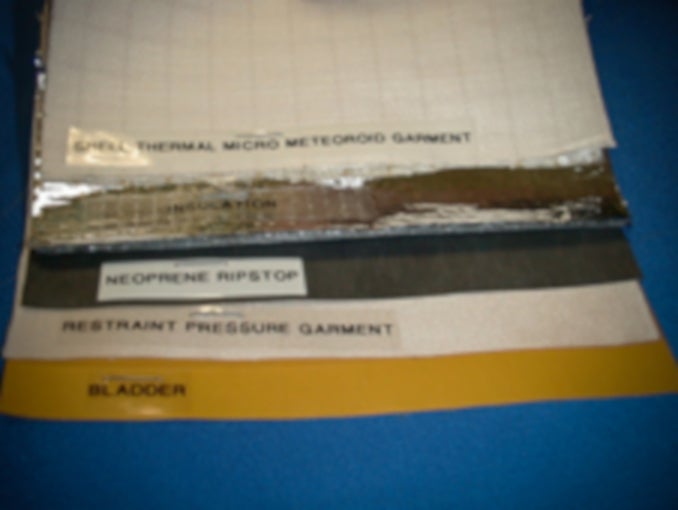
Layers of the spacesuit (EMU). This image was quite small and had to be enlarged but is still blurry. Image from Nasa.gov.

Having delved into the weight issue, extreme temps, and excluded rifles from the mix, but adding armor, we’ve just narrowed down the list of possible guns to choose from in a hurry. Now that the bigger challenges to bringing guns into space have been addressed, in Part 2, I’ll cover the calibers and guns that I think fit the bill for arming the new Space Force.
What do you think? Are there other hurdles I didn’t cover? Based on the factors above, what do you think the best space gun would be?
guns
via The Firearm Blog https://ift.tt/2JX8W99
December 24, 2019 at 08:04PM
What is Technical Debt?
https://ift.tt/34X6uVX
Technical debt is a plague on software development in companies big and small. But what is it? What problems does it cause? How can we remove it? Watch this video blog from Robert Pieper, CEO of Responsive Advisors to find out.
scrum/agile
via Scrum.org Blog https://ift.tt/2TTJdzo
December 26, 2019 at 02:21PM
Gun Grabbers Respond to the Assault on Nakatomi Plaza
https://ift.tt/2Zlmyzz
The harrowing events of the siege on Los Angeles’s Nakatomi Plaza took place 31 years ago. That tragic incident and the heroic response by one off-duty police officer were recounted in a now beloved documentary that recounts what is widely considered to be a Christmas miracle.
We can all be thankful, however, that those terrifying events didn’t take place in 2019. In this age of social media, we’re all too familiar with politicians and the gun control community opportunistically using the acts of madmen like Hans Gruber and his band of terrorists to push their anti-gun agenda.
If the Nakatomi Plaza assault took place today, what would their response look like? Here are some very possible likely tweets:
Let’s not forget HRC:
For our readers in Illinois:
Merry Die Hard day.
guns
via The Truth About Guns https://ift.tt/1TozHfp
December 24, 2019 at 03:29PM
The Rimfire Report: The Summer Olympic Rimfire Sports
https://ift.tt/39beVjU
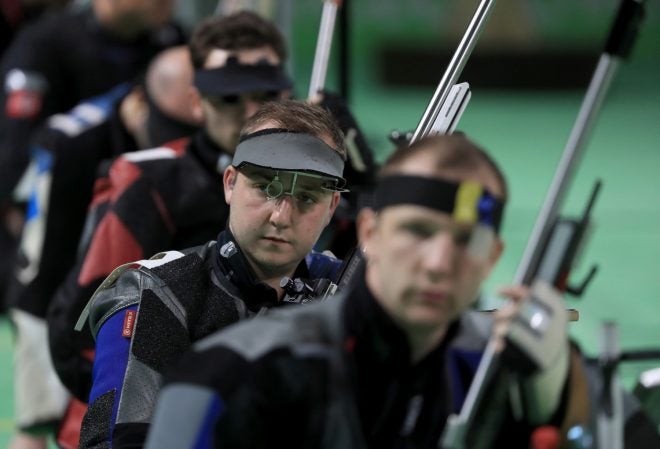
Image Source: https://ift.tt/1U7xsQX
Previously on The Rimfire Report, we briefly went over a shooting sport conducted during the winter Olympics – The Biathlon. However, the summer Olympics has its own set of shooting sports which include both rimfire rifles and pistols. Today we’ll briefly go over some of the rules, equipment, and disciplines involved in the Shooting Sports for the upcoming 2020 Summer Olympics being hosted at the Asaka Shooting range in Japan. Olympic Rimfire sports have a long history dating back to the beginning of the modern games in 1896.
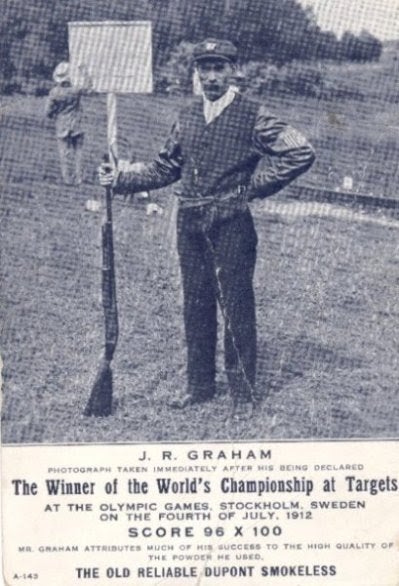
Olympic Rimfire – Not wielding a rimfire but participating in an Olympic Shooting Sport – James R. Graham in 1912 just after claiming Gold in Olympic Trap Shooting
As the name implies, this competition involves shooting at a 25-meter distance with a pistol, specifically a rimfire pistol. The 25 Meter Rapid Fire Pistol event is derived from the ISSF (International Sport Shooting Federation). The ISSF also recognizes several other Olympic shooting sports including events involving shotguns.
This 25-meter Rapid Fire Pistol event is always shot with .22 LR pistols. Competitors will use their highly specialized pistols to engage a target with 5 shots. Each set of 5 shots constitutes a string and is graded by accuracy. Each target must be engaged using only one hand, making the shots incredibly difficult to master.
Competitors start from a “low and ready” position that is 45 degrees down from their starting position. There are three different time limits for the series: 8 seconds, 6 seconds, and 4 seconds. A stage consists of two series of each type, and a full course of fire comprises two such stages or a total of 60 shots. Since the targets are divided into concentric score zones with 10 being the most central part, the total maximum score is 600. Iron sights are the only sights that are used in the Olympic 25 Meter Rapid Fire competition.
6 finalists eventually go on to compete in an elimination-style match which includes their cumulative score until the winner is determined after 8 total strings (series) and 40 shots.
25 Meter Rapid Fire Pistol has been a part of the Olympic games as far back as 1896. The Rules changed significantly over time, especially before WWII. Some of the changes came at the expense of performance however as in 2005 new rules were put in place that restricted the types of grips and trigger pull weights that were legal to use. In 1989 the sport also banned the use of .22 Short cartridges under the blanket rule change of limiting the competition to “Sport Pistols” only.
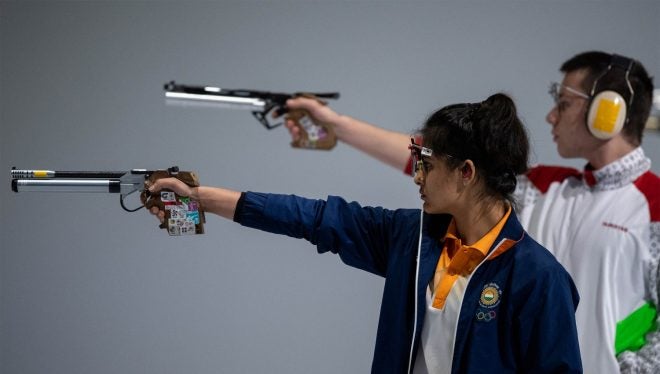
Olympic Rimfire
This series of rule changes saw companies like Walther making bids to design completely new pistols to conform to the requirements of the Olympic sport and ISSF. One such pistol – the Walther SSP is an extremely odd-looking pistol. The SSP replaced the OSP which was rendered obsolete by the rule changes in 2005.

Olympic Rimfire Sports
The Walther SSP makes use of detachable 5 round magazines, weighs 34 oz, has a 6-inch barrel and features an extremely light 2.2 lb (or 1000 gram) trigger pull. If you’re looking to get into Olympic pistol competitions, one of these pistols will set you back $2,095.00 just to start, and this doesn’t include years of training or magazines – and all that ammo you’ll be practicing with.
This three-position competition involves shooting from a standing, kneeling and prone position during the course of fire. During the event, each competitor must complete the course of fire within a limited time frame of 2 hours and 45 minutes. Naturally, only .22 LR rimfire rifles are used.
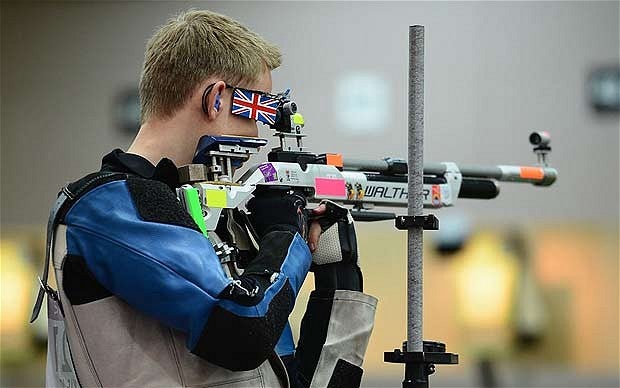
Olympic Rimfire – James Huckle of the UK participates in Three Positions 50 M Rifle
The target used is a 6 inch black and white target with several rings used for grading the accuracy of the shooter. The target is placed at a fixed height above the floor of the shooting range at .75 meters or just under 2.5 feet.
Until recently, men and women competed by different standards with women’s competitions tending to be shorter and with shorter courses of fire. Each course of fire follows in the following order: Kneeling – 40 shots, Prone – 40 shots and Standing – 40 shots. This is considered a qualification course of fire. Following the qualification round, the top 8 shooters will fire an additional 10 shots one at a time in the standing position. The winner of the match is the shooter with the highest score from both the qualification and final rounds.
Rifles used in the three-position target match tend to be made by three competing companies. Anschutz makes many rifles used in this competition as well as the Biathlon. Feinwerkbau and Walther also make rifles in the rimfire target category and it goes without saying that all three options cost quite a bit even at their base price.
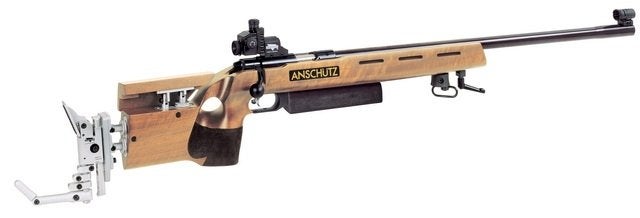
Olympic Rimfire Sports – An example of an Anschutz 50 M 3 Positions rifle. A simple Bolt Action is used to load and unload the single-shot rifle
Where in biathlon competitions you are striving for the lightest rig possible for skiing, in the 50 Meter Three-position weight is not as much of issue whereas accuracy and consistency are. All rifles used in the 50-meter competition are bolt action single shot .22 LR rifles. Materials and trigger tuning will vary greatly depending on the preferences of the shooter with Walnut and synthetic stocks being common sights along with adjustable cheekpieces on the competitor’s stock.
The Summer Olympic Games are a great opportunity for all participating countries to showcase their best athletes. I am glad that we live in an age and time that allows for everyone to participate in this sport – even countries that have heavier restrictions on firearms than the United States.
So if you find time this coming Summer, check out the Shooting Sports that are showcased. A couple others not mentioned in this article are the 50 Meter Prone shooting which also uses .22 rimfire rifles. There is also an extremely exciting Olympic Trapshooting competition in addition to the Olympic Rimfire sports. Thanks again for stopping by to read The Rimfire Report. What are some shooting sports around the world you’re looking forward to? Let us know down in the comments.
We are committed to finding, researching, and recommending the best products. We earn commissions from purchases you make using the retail links in our product reviews.
Learn more about how this works
.
guns
via The Firearm Blog https://ift.tt/2JX8W99
December 23, 2019 at 07:00PM
How Highlighters Are Made
https://ift.tt/2t0qZ6B
As we’ve moved away from print and towards digital reading, highlighters aren’t as popular as they once were. But these fluorescent pens are still pretty cool for making art. Science Channel’s How It’s Made shows the process of molding the plastic bodies, filling their nibs with ink, and testing them for smooth flow.
fun
via The Awesomer https://theawesomer.com
December 23, 2019 at 04:02PM
MySQL 8.0 & PHP on RedHat, CentOS and Fedora
https://ift.tt/2EGGjbo
As you could read in this previous post, PHP 7.4 is now completely supporting MySQL 8.0 and the new default authentication plugin.
I wanted to make a summary table providing and overview of all PHP versions and how they supported MySQL 8.0 and the different authentication plugins.
As I am a RPM based distribution user, I’m using the famous repository of remi since a lot of years, and I use it then also to install PHP 7.4.0 and 7.4.1…
I created a new user to test to connect with PHP and then… I was surprised to see that I could not connect to MySQL using caching_sha2_password. Of course I tried to see if my credentials were correct using the MySQL client… and I could connect… Then I tried again my PHP script and new surprise, I could connect !?!
I could connect because the password was cached. If I run FLUSH PRIVILEGES, then the PHP script could not connect anymore.
The error was:
Trying with caching_sha2_password.... PHP Warning: mysqli::__construct(): (HY000/1045): Access denied for user 'fred_secure'@'mysql-dc1-2' (using password: YES)
I discussed this with my colleagues. They tried ith the same PHP version and they could not reproduce my error… but they were using Ubuntu.
What’s wrong ?
So I decided to compile from scratch PHP 7.4 on my CentOS 8 box… and… it worked as expected !
After a lot of debugging, testing many openSSL versions and compilation more than 10 times PHP… I was able to find the difference and compile a rpm based on Remi‘s spec file.
The problem was in mysqli.so.
I don’t explain yet why this is a problem, and I already reported this to my colleagues, but the difference between Ubuntu packages and my compiled from scratch version and the one installed from Remi’s repo, is the absence of value for mysqli.default_socket:
mysqli.default_socket => no value => no value
So, I’ve rebuild Remi’s package removing --with-mysql-sock=%{mysql_sock} \ and it worked !
I will now wait for feedback from the developers to understand the reason and see if this is a bug. However, if you want already to use PHP 7.4.1 and MySQL 8.0 on any RedHat based distribution, you will need to have a new php74-php-mysqlnd package.
You can download this one for el8 (RedHat, Oracle Linux and CentOS):
The package is built in way that you don’t need to update all PHP 7.4 packages, but only the mysqlnd one, like this:
rpm -Uvh php74-php-mysqlnd-7.4.1-2.el8.remi.x86_64.rpm
Verifying… ################# [100%]
Preparing… ################# [100%]
Updating / installing…
1:php74-php-mysqlnd-7.4.1-2.el8.rem################# [ 50%]
Cleaning up / removing…
2:php74-php-mysqlnd-7.4.1-1.el8.rem################# [100%]
I hope this can help you if you faced some authentication issue with PHP 7.4 and MySQL 8.0.
technology
via Planet MySQL https://ift.tt/2iO8Ob8
December 22, 2019 at 07:17PM